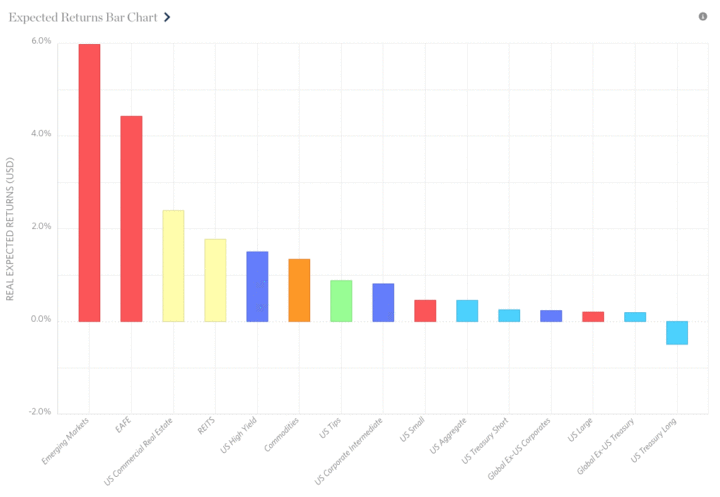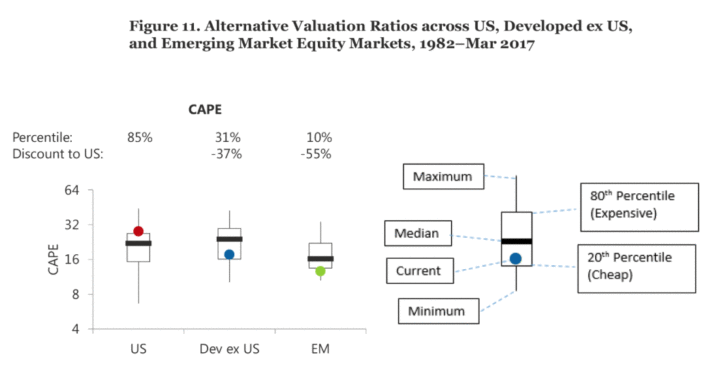 Investment advisory firm Research Affiliates has an interactive Asset Allocation tool that provides estimates of expected returns for many different asset classes and model portfolios. Their default model is based on valuations like the CAPE (cyclically adjusted PE, or Shiller PE) ratio that divides the current price by 10 years worth of earnings. If you believe that valuations like price/earnings and price/book matter, then this database helps show you what is relatively “cheap” or “expensive” in such terms.
Investment advisory firm Research Affiliates has an interactive Asset Allocation tool that provides estimates of expected returns for many different asset classes and model portfolios. Their default model is based on valuations like the CAPE (cyclically adjusted PE, or Shiller PE) ratio that divides the current price by 10 years worth of earnings. If you believe that valuations like price/earnings and price/book matter, then this database helps show you what is relatively “cheap” or “expensive” in such terms.
Here’s an updated snapshot of expected returns for several major asset classes, as of January 2018. Click to enlarge.
You can see that Emerging Markets and Developed International (EAFA or Europe, Australasia and the Far East) have the highest current expected return. This is explored more in-depth in their article CAPE Fear: Why CAPE Naysayers Are Wrong. Here’s a chart that summarizes their position:
Takeaways:
- US stocks are still relatively expensive based on historical values. Future 10-year expected average returns are around 1% above inflation.
- Broad US (Core) Bonds, Long-term US Treasuries, Short-Term Treasuries, and TIPS are all expected to have low forward returns. Their low current yields offer little alternative.
- Emerging Markets stocks, Developed International (EAFA) stocks, and Emerging Markets bonds (both local currency) are relative bright spots with the highest future expected returns.
These numbers are not very useful as a timing to jump in and out of something. The US has been highly valued for a couple years, yet returns for those last two years have also been quite high. However, Research Affiliates maintains that CAPE and similar valuation tools are a powerful predictor of long-term market returns.
I like holding both US and international stocks in my personal portfolio, and I have been slightly overweight emerging markets for a decade. Emerging markets have been hurting my overall returns for a while now, but knowing that they are “cheap” makes it easier to keep holding them in the hopes of riding the next upward wave. Of course, I’m holding onto my US stocks as well.
p.s. The most recent GMO letter by Jeremy Grantham also puts Emerging Markets as the “single reasonably-priced asset class”.


 The Best Credit Card Bonus Offers – 2025
The Best Credit Card Bonus Offers – 2025 Big List of Free Stocks from Brokerage Apps
Big List of Free Stocks from Brokerage Apps Best Interest Rates on Cash - 2025
Best Interest Rates on Cash - 2025 Free Credit Scores x 3 + Free Credit Monitoring
Free Credit Scores x 3 + Free Credit Monitoring Best No Fee 0% APR Balance Transfer Offers
Best No Fee 0% APR Balance Transfer Offers Little-Known Cellular Data Plans That Can Save Big Money
Little-Known Cellular Data Plans That Can Save Big Money How To Haggle Your Cable or Direct TV Bill
How To Haggle Your Cable or Direct TV Bill Big List of Free Consumer Data Reports (Credit, Rent, Work)
Big List of Free Consumer Data Reports (Credit, Rent, Work)
Interesting chart. Clearly, with elevate CAPE ratios, a “reversion to the mean” is likely over the next decade for US large caps. I’ve shifted a bit of my US Large Cap winnings into International equities over the past few weeks. Not trying to time the market, just doing some reasonable rebalancing. Thanks for sharing.